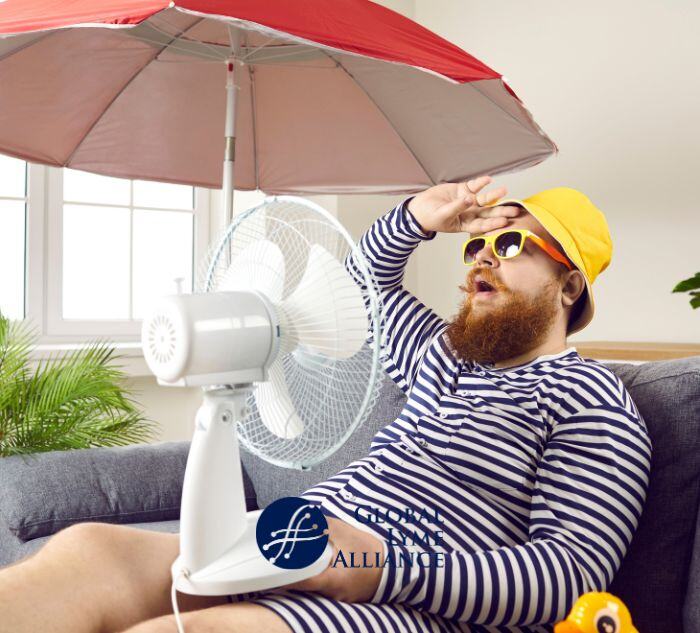
Learn how extreme temperatures can worsen Lyme symptoms and discover essential tips to stay cool and manage the effects of heat waves on Lyme patients in this insightful blog post by Jennifer Crystal.
" I didn’t know that extreme temperatures can exacerbate Lyme symptoms, and that my already compromised system was fighting a much bigger battle than typical overheating. I didn’t know that the hot sun was enraging the bacteria in my body, bringing it—and its inflammatory manifestations, like the migraine—to the surface."
When I opened up Facebook on July 4th, the app showed me a photo I’ve posted every year on that day since I joined the site. The scene is summer camp in Maine—where I got my original tick bite—and the year is 2002. My fellow Head Counselors and I are gathered around a hot grill, making pancakes on one of the hottest Independence Days on record. The temperature was 105 degrees.
Decked out in red, white and blue, my friends and I are smiling in the photo. I may have put on a good face—something Lymies do far too often—but inside, I felt like I was dying. Or said in another way, I felt like I was burning up.
July 4, 2002 was a brutally hot day for everyone involved. When I re-post that photo, my friends write the same comments every time: “The hottest I ever was.” “Even the lake was hot.” “The barometer for all other hot days. Am I hot? Yes. Am I July 4, 2002 hot? No? Then I’ll survive.”
All joking aside, I remember feeling like I legitimately might not survive that scorching day. Everyone was sweating, everyone was complaining, everyone was drinking lots of water. But I’d already downed two water bottles by the time I finished cooking breakfast, and still had a headache coming on. By noon that headache had turned into a full-blown migraine; the pressure was such that I wondered if my brain might explode right out of my skull. It felt like nails were being hammered into my left eyelid, over and over. I spent the afternoon sacked out on my bed, chiding myself for not being able to suck it up and play Capture the Flag. I felt weak and ashamed—not to mention nauseous, exhausted and debilitated by excruciating pain.
What I didn’t know was that my body had been harboring tick-borne diseases for five years at that point. I didn’t know that extreme temperatures can exacerbate Lyme symptoms, and that my already compromised system was fighting a much bigger battle than typical overheating. I didn’t know that the hot sun was enraging the bacteria in my body, bringing it—and its inflammatory manifestations, like the migraine—to the surface.
Why does heat affect Lyme so severely? For starters, spirochetes can’t live at very high temperatures. This is why some Lyme patients use infrared saunas, to try and kill off—and sweat out—the Lyme bacteria. Use of these saunas is controversial, however, because they make some patients much sicker. That’s because killing spirochetes at such a high and fast rate can cause a Herxheimer reaction, leaving the body full of dead toxins that it can’t efficiently eliminate. A day in the hot sun can have the same effect.
Another reason Lymies can’t tolerate extreme temperatures, both hot and cold, is because tick-borne diseases can damage the nervous system. Some patients’ bodies have trouble regulating blood pressure and heart rate, and extreme temperatures can send those processes into distress. Common Lyme symptoms of dizziness, fatigue, and joint aches—hard enough to deal with on a moderate day—are intensified in the heat of summer or the bitterness of winter. And because our nervous systems are out of whack, we often can’t recognize that we’re getting too hot or too cold until it’s too late.
I liken this sensation—or lack thereof—to being a lobster in a slow-boiling pot. You’ve all heard the explanation for why lobsters don’t try to climb out of their cooking pots: because the water temperature is slowing rising, the lobsters don’t notice what’s happening until they’re cooked. The same is true for Lymies on hot days. I can be outside feeling fine…fine…fine…and then suddenly, seemingly out of nowhere, I am not fine. Suddenly my face is on fire, my heart is racing, my glands are leaking sweat, and I’m feeling dizzy and faint.
Lyme treatment can also intensify these effects, since many medications (especially antibiotics in the tetracycline family) cause phototoxicity. If you are on one of these medicines, you can’t be in the sun at all, but even umbrellas, hats, and sunglasses don’t protect overheating. High temperatures and humidity, rampant at this time of year, are a dangerous mix for Lyme patients.
So what’s a Lymie to do? Here are a few suggestions for keeping cool:
- Stay in—This may seem obvious, but when healthy friends are out playing in the sunshine and you have enough energy to join them for a bit, it can be really hard to say no. Remember, though, that your energy will be depleted much faster than usual in high heat. Cooler days will come, with better energy to go with them. Don’t waste what little reserves you have on a 100 degree day. If your home doesn’t have air-conditioning, see if you can stay with a friend, or rest at a local cooling center. Fans are not enough to cool an overheated Lymie.
- Take breaks—Even if you’re feeling okay when you’re outside, your body will likely overheat without warning. Try to give yourself breaks before this happens, by ducking in to air-conditioned buildings or sitting in the shade.
- Hydrate—I don’t just mean order a cold drink when you stop in to one of those air-conditioned places. I mean carry water with you at all times. Make sure you have more than enough with you for your outing, no matter how short it may be. You never know when you will get stuck in line at the pharmacy, and suddenly that overheated feeling comes on…
- Indulge in cool treats—Without breaking the Lyme diet, you can enjoy refreshing treats. You may not be able to sip a frozen daiquiri, but you can drink flavored seltzer with ice, smoothies, and all-natural lemonade; you can eat naturally-sweetened ice cream (So Delicious is my personal favorite); and you can have popsicles like Paleo Frozen Pops or Luna and Larry’s Organic Coconut Bliss Bars.
- Take a lukewarm shower—Your instinct might be to take a cold shower, but your body will have to work harder to regulate its temperature afterwards. Let the shower do the regulating for you!
- Put your wrists in cool water—The pressure points on your wrists, and also on your ankles, react quickly to cool temperatures, and can spread that coolness around your body. Run the veins of your wrists under a tap to quickly lower your body temperature.
- Put a cool compress over your face and neck—Similar to putting your wrists or ankles in cool water, this trick is a quick way to lower your body temperature.
- Invest in a cooling towel—Sold at sports shops and at stores like Bed Bath and Beyond, Lowes, and Walmart, these towels are basically the opposite of heating pads. While running your own towel under cool water works just fine, these towels are specifically designed to quickly chill you, and are made to target certain areas of your body.
And finally, as always, be gentle with yourself. You are suffering from an insidious disease that rears its ugly head when the sun blazes down. Don’t chide yourself the way I did. You are not weak. You have angry spirochetes in your body, and if you treat them kindly during the heat wave, they just may let you go out to eat lobster, instead of becoming one. Then you can smile in the photo for real.
***

Jennifer Crystal
Writer
Opinions expressed by contributors are their own. Jennifer Crystal is a writer and educator in Boston. Her work has appeared in local and national publications including Harvard Health Publishing and The Boston Globe. As a GLA columnist for over six years, her work on GLA.org has received mention in publications such as The New Yorker, weatherchannel.com, CQ Researcher, and ProHealth.com. Jennifer is a patient advocate who has dealt with chronic illness, including Lyme and other tick-borne infections. Her memoir, One Tick Stopped the Clock, was published by Legacy Book Press in 2024. Ten percent of proceeds from the book will go to Global Lyme Alliance. Contact her via email below.







